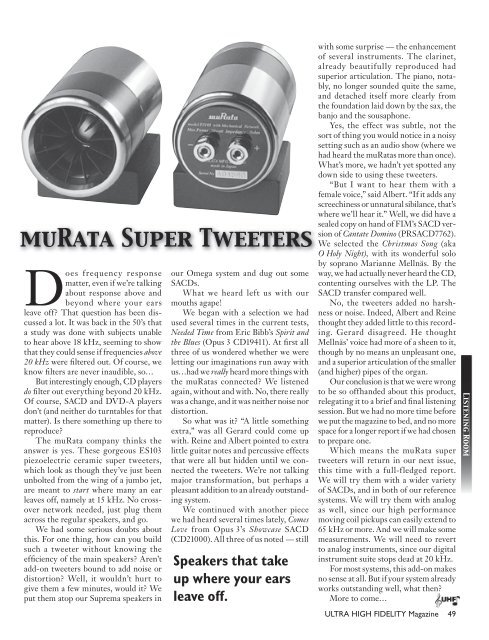UHF No 70 (Net).indd - Ultra High Fidelity Magazine
UHF No 70 (Net).indd - Ultra High Fidelity Magazine
UHF No 70 (Net).indd - Ultra High Fidelity Magazine
Create successful ePaper yourself
Turn your PDF publications into a flip-book with our unique Google optimized e-Paper software.
muRata Super Tweeters<br />
Does frequency response<br />
matter, even if we’re talking<br />
about response above and<br />
beyond where your ears<br />
leave off? That question has been discussed<br />
a lot. It was back in the 50’s that<br />
a study was done with subjects unable<br />
to hear above 18 kHz, seeming to show<br />
that they could sense if frequencies above<br />
20 kHz were fi ltered out. Of course, we<br />
know fi lters are never inaudible, so…<br />
But interestingly enough, CD players<br />
do fi lter out everything beyond 20 kHz.<br />
Of course, SACD and DVD-A players<br />
don’t (and neither do turntables for that<br />
matter). Is there something up there to<br />
reproduce?<br />
The muRata company thinks the<br />
answer is yes. These gorgeous ES103<br />
piezoelectric ceramic super tweeters,<br />
which look as though they’ve just been<br />
unbolted from the wing of a jumbo jet,<br />
are meant to start where many an ear<br />
leaves off, namely at 15 kHz. <strong>No</strong> crossover<br />
network needed, just plug them<br />
across the regular speakers, and go.<br />
We had some serious doubts about<br />
this. For one thing, how can you build<br />
such a tweeter without knowing the<br />
effi ciency of the main speakers? Aren’t<br />
add-on tweeters bound to add noise or<br />
distortion? Well, it wouldn’t hurt to<br />
give them a few minutes, would it? We<br />
put them atop our Suprema speakers in<br />
our Omega system and dug out some<br />
SACDs.<br />
What we heard left us with our<br />
mouths agape!<br />
We began with a selection we had<br />
used several times in the current tests,<br />
Needed Time from Eric Bibb’s Spirit and<br />
the Blues (Opus 3 CD19411). At fi rst all<br />
three of us wondered whether we were<br />
letting our imaginations run away with<br />
us…had we really heard more things with<br />
the muRatas connected? We listened<br />
again, without and with. <strong>No</strong>, there really<br />
was a change, and it was neither noise nor<br />
distortion.<br />
So what was it? “A little something<br />
extra,” was all Gerard could come up<br />
with. Reine and Albert pointed to extra<br />
little guitar notes and percussive effects<br />
that were all but hidden until we connected<br />
the tweeters. We’re not talking<br />
major transformation, but perhaps a<br />
pleasant addition to an already outstanding<br />
system.<br />
We continued with another piece<br />
we had heard several times lately, Comes<br />
Love from Opus 3’s Showcase SACD<br />
(CD21000). All three of us noted — still<br />
Speakers that take<br />
up where your ears<br />
leave off.<br />
with some surprise — the enhancement<br />
of several instruments. The clarinet,<br />
already beautifully reproduced had<br />
superior articulation. The piano, notably,<br />
no longer sounded quite the same,<br />
and detached itself more clearly from<br />
the foundation laid down by the sax, the<br />
banjo and the sousaphone.<br />
Yes, the effect was subtle, not the<br />
sort of thing you would notice in a noisy<br />
setting such as an audio show (where we<br />
had heard the muRatas more than once).<br />
What’s more, we hadn’t yet spotted any<br />
down side to using these tweeters.<br />
“But I want to hear them with a<br />
female voice,” said Albert. “If it adds any<br />
screechiness or unnatural sibilance, that’s<br />
where we’ll hear it.” Well, we did have a<br />
sealed copy on hand hand of FIM’s SACD version<br />
of Cantate Domino (PRSACD7762).<br />
We selected the Christmas Song (aka<br />
O Holy Night), with its wonderful solo<br />
by soprano Marianne Mellnäs. By the<br />
way, we had actually never heard the CD,<br />
contenting ourselves with the LP. The<br />
SACD transfer compared well.<br />
<strong>No</strong>, the tweeters added no harshness<br />
or noise. Indeed, Albert and Reine<br />
thought they added little to this recording.<br />
Gerard disagreed. He thought<br />
Mellnäs’ voice had more of a sheen to it,<br />
though by no means an unpleasant one,<br />
and a superior articulation of the smaller<br />
(and higher) pipes of the organ.<br />
Our conclusion is that we were wrong<br />
to be so offhanded about this product,<br />
relegating it to a brief and fi nal listening<br />
session. But we had no more time before<br />
we put the magazine to bed, and no more<br />
space for a longer report if we had chosen<br />
to prepare one.<br />
Which means the muRata super<br />
tweeters will return in our next issue,<br />
this time with a full-fledged report.<br />
We will try them with a wider variety<br />
of SACDs, and in both of our reference<br />
systems. We will try them with analog<br />
as well, since our high performance<br />
moving coil pickups can easily extend to<br />
65 kHz or more. And we will make some<br />
measurements. We will need to revert<br />
to analog instruments, since our digital<br />
instrument suite stops dead at 20 kHz.<br />
For most systems, this add-on makes<br />
no sense at all. But if your system already<br />
works outstanding well, what then?<br />
More to come…<br />
ULTRA HIGH FIDELITY <strong>Magazine</strong> 49<br />
Listening Room

















